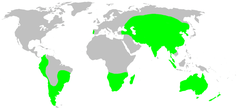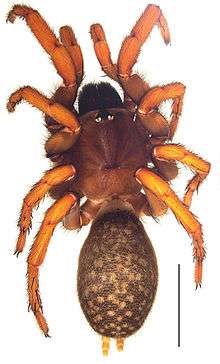Nemesiidae
Nemesiidae, also known as funnel-web trapdoor spiders, is a family of mygalomorph[1] spiders first described by Eugène Simon in 1889,[2] and raised to family status in 1985. Before becoming its own family, it was considered part of "Dipluridae".[3] Fossils have been found dating this family back to the Lower Cretaceous.[4]
| Funnel-web tarantulas | |
|---|---|
.jpg) | |
| Calisoga sp. | |
| Scientific classification | |
| Kingdom: | Animalia |
| Phylum: | Arthropoda |
| Subphylum: | Chelicerata |
| Class: | Arachnida |
| Order: | Araneae |
| Infraorder: | Mygalomorphae |
| Clade: | Avicularioidea |
| Family: | Nemesiidae Simon, 1889 |
| Diversity | |
| 45 genera, 456 species | |
 | |
Description

Nemesiidae are relatively large spiders with robust legs and a body that is nearly three times as long as it is wide. They are darkly colored, brown to black, though some have silvery hairs on their carapace.[5] Atmetochilus females can grow over 4 centimetres (1.6 in) long.
They live in burrows, often with a hinged trapdoor. This door is pushed up while the spider waits for passing prey. They rarely leave their burrows, catching prey and withdrawing as quickly as possible. Some of these burrows have a side tubes, but it is not certain whether Sinopesa builds burrows at all.[6]
Genera

As of July 2020, the World Spider Catalog accepts the following genera:[7]
- Amblyocarenum Simon, 1892
- Brachythele Ausserer, 1871 — Europe, Cyprus
- Calisoga Chamberlin, 1937 — United States
- Chaco Tullgren, 1905 — Argentina, Uruguay, Chile
- Chilelopsis Goloboff, 1995 — Chile
- Damarchilus Siliwal, Molur & Raven, 2015
- Diplothelopsis Tullgren, 1905 — Argentina
- Flamencopsis Goloboff, 1995 — Chile
- Gravelyia Mirza & Mondal, 2018 — India
- Hermachura Mello-Leitão, 1923 — Brazil
- Iberesia Decae & Cardoso, 2006 — Africa, Europe
- Longistylus Indicatti & Lucas, 2005 — Brazil
- Lycinus Thorell, 1894 — Chile, Argentina, Brazil
- Mexentypesa Raven, 1987 — Mexico
- Nemesia Audouin, 1826 — Africa, Europe, Cuba, China
- Neostothis Vellard, 1925 — Brazil
- Prorachias Mello-Leitão, 1924 — Brazil
- Psalistopoides Mello-Leitão, 1934 — Brazil
- Pselligmus Simon, 1892 — Brazil
- Rachias Simon, 1892 — Brazil, Argentina
- Raveniola Zonstein, 1987 — Asia
- Sinopesa Raven & Schwendinger, 1995 — Asia
Transferred to other families:[8][9][10][11][12]
- Acanthogonatus Karsch, 1880 → Pycnothelidae
- Atmetochilus Simon, 1887 → Bemmeridae
- Aname L. Koch, 1873 → Anamidae
- Bayana Pérez-Miles, Costa & Montes de Oca, 2014 → Pycnothelidae
- Chenistonia Hogg, 1901 → Anamidae
- Damarchus Thorell, 1891 → Bemmeridae
- Entypesa Simon, 1902 → Entypesidae
- Hermacha Simon, 1889 → Entypesidae
- Hesperonatalius Castalanelli, Huey, Hillyer & Harvey, 2017 → Anamidae
- Ixamatus Simon, 1887 → Microstigmatidae
- Kiama Main & Mascord, 1969 → Microstigmatidae
- Kwonkan Main, 1983 → Anamidae
- Lepthercus Purcell, 1902 → Entypesidae
- Namea Raven, 1984 → Anamidae
- Pionothele Purcell, 1902 → Pycnothelidae
- Proshermacha Simon, 1908 → Anamidae
- Pycnothele Chamberlin, 1917 → Pycnothelidae
- Spiroctenus Simon, 1889 → Bemmeridae
- Stanwellia Rainbow & Pulleine, 1918 → Pycnothelidae
- Stenoterommata Holmberg, 1881 → Pycnothelidae
- Swolnpes Main & Framenau, 2009 → Anamidae
- Teyl Main, 1975 → Anamidae
- Teyloides Main, 1985 → Anamidae
- Xamiatus Raven, 1981 → Microstigmatidae
See also
References
- Raven, R.J. (1987). "A new mygalomorph spider genus from Mexico (Nemesiinae, Nemesiidae, Arachnida)" (PDF). J. Arachnol. 14: 357–362.
- Simon, E. (1889). Arachnides.
- Raven, R.J. (1985). "The spider Infraorder Mygalomorphae (Araneae): cladistics and systematics". Bulletin of the American Museum of Natural History. 182.
- Selden, P.A. (2001). "Eocene spiders from the Isle of Wight with preserved respiratory structures". Palaeontology. 44 (4): 695–729. doi:10.1111/1475-4983.00199. hdl:1808/8359.
- "Find-a-Spider Guide". University of Queensland. 2006-07-07. Retrieved 2019-04-22.
- Murphy, Frances; Murphy, John (2000). An Introduction to the Spiders of South East Asia. Malaysian Nature Society, Kuala Lumpur.
- "Family: Nemesiidae Simon, 1889". World Spider Catalog. Natural History Museum Bern. Retrieved 2020-07-25.
- "Family: Pycnothelidae Chamberlin, 1917". World Spider Catalog. Natural History Museum Bern. Retrieved 2020-07-11.
- "Family: Anamidae Simon, 1889". World Spider Catalog. Natural History Museum Bern. Retrieved 2020-07-11.
- "Family: Entypesidae Bond, Opatova & Hedin, 2020". World Spider Catalog. Natural History Museum Bern. Retrieved 2020-07-11.
- "Family: Microstigmatidae Roewer, 1942". World Spider Catalog. Natural History Museum Bern. Retrieved 2020-07-11.
- "Family: Bemmeridae Simon, 1903". World Spider Catalog. Natural History Museum Bern. Retrieved 2020-07-11.
External links
| Wikispecies has information related to Nemesiidae |
| Wikimedia Commons has media related to Nemesiidae. |
Further reading
- Pesarini, C. (1988): Revision of the genus Pycnothele (Araneae, Nemesiidae). J. Arachnol. 16: 281-293. PDF
- Rafael P. Indicatti & Sylvia M. Lucas (2005): Description of a new genus of Nemesiidae (Araneae, Mygalomorphae) from the Brazilian Cerrado. Zootaxa 1088: 11-16. PDF (Longistylus)
- Indicatti, Rafael P.; Lucas, Sylvia M.; Ott, Ricardo & Brescovit, Antonio D. (2008): Litter dwelling mygalomorph spiders (Araneae: Microstigmatidae, Nemesiidae) from Araucaria forests in southern Brazil, with the description of five new species. Revista Brasileira de Zoologia 25(3): 529-546.